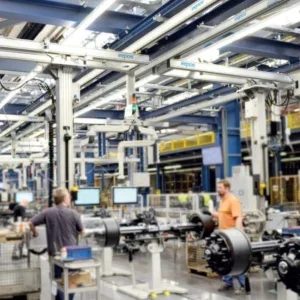The first afternoon concluded with a fascinating presentation by Walter Heinrich, factory and construction crane inspector, and Kjell Andersson, crane inspector, (both of Inspecta) on fatigue cracking in industrial cranes.
At no point during the event was the devastation caused by accidents more clear than when Kjell Andersson explained an incident at a Swedish steel mill in which a break down on the primary shaft between the gear box and working brake led to over 50t of molten steel falling 15m to the floor.

Kjell Andersson explained an accident at a Swedish steel mill in which a break down on the primary shaft between the gear box and working brake led to over 50t of molten steel falling 15m to the floor
The broken teeth from inside the gear box were collected and put on show at the conference (the almost unidentifiable shards of metal weighed over 8kg). The audience were invited to inspect a bag containing the broken teeth – one of a range of exhibits on show during the presentation demonstrating damage to lifting gear and components.
An investigation into this accident is still taking place. Kjell Andersson said: “Standard EN 13135-2 says that bridge cranes (over 40t capacity) must be equipped with a safety brake on the hoisting drum. This type of brake had stopped the ladle from falling.” The steel mill is in the middle of a modernisation project, which includes the installment of such a safety device.

Bob Crompton, of Rayco Wylie Systems, inspects a bag of broken gear box teeth during Walter Heinrich and Kjell Andersson’s presentation
Other speakers on day one included Mammoet safety manager Bryan Cronie. He explained that, back in 2005, he was due to speak at Crane Safety, that year in Amsterdam, but he had been called away to a serious accident in Qatar, involving Mammoet’s giant strand jack-lifting system, the MSG 50.
The accident had taken place when staff were replacing pins connecting the crane pendants to hydraulic rams. These had been found to fit too tightly, and had been sent away to be skimmed. While this took place, the 3t pendants were supported with timber blocks.
When they were returned, the job supervisor climbed onto the MSG head, were the part replacement was taking place, and pushed the hydraulic cylinders away from the timber supports. As he did, the timber supports slid away from the pendants, and one pendant struck the supervisor. A second pendant then trapped him by the wrist, seriously injuring him and causing long term damage to his hand.
Not that this was a crane accident as such, but it was an example early in the conference of the cost and devastation that can be caused to companies, individuals and, moreover, their families.
Also on the first day, LEEA chief executive and Hoist columnist Derrick Bailes and Mike Rock, safety manager at RWE npower, explored lifting operations in the UK power generation industry. They explained how the organisation of lifting operations has been affected by changes in the industry and the benefits of standardised training and assessment of location lifting specialists.
The day concluded with a presentation from Eric Schmieman, safety manager, and Philippe Convert, project manager, at the Chernobyl containment project, where overhead cranes are being remote controlled in a highly radioactive environment. Their paper will be published in an upcoming issue of Hoist.
The second day’s factory crane session was opened with a discussion about anti-sway controls from Kimmo Hytönen of Innocrane, followed by Frans Busschots, crane project Manager, ABB Belgium, who discussed crane control equipment on the job site.
Following that, Mike Palmer (maintenance authority and principal lifting engineer) and Dai Davies (lifting equipment centre of expertise leader) at British Nuclear Group Sellafield took an audience through a cradle-to-grave view of overhead crane safety issues at Sellafield.
That particular session concluded with a presentation from Alan John, technical manager at Reliance Barker Davies, and Jean-Paul Vedrenne, technical director, Norisko Equipment, discussing French requirements for proof-load testing of overhead cranes, the benefits and risks of this testing procedure and the problems these regulations pose, and potential solutions.
The event was concluded with a workshop led by wire rope designer Roland Verreet.
All presentations from Crane Safety 2007 can be downloaded at www.wilmingtonconferences.com/cranesafety2007.
Kjell Andersson explained an accident at a Swedish steel mill in which a break down on the primary shaft between the gear box and working brake led to over 50t of molten steel falling 15m to the floor conference 1 Kjell Andersson said: ‘Standard EN 13135-2 says that bridge cranes (over 40t capacity) must be equipped with safety break on the hoisting drum. This type of break had stopped the ladle from falling.’ conference 2 Bob Crompton, of Rayco Wylie Systems, inspects a bag of broken gear box teeth during Walter Heinrich and Kjell Andersson’s presentation conference 3 The power and energy-themed event was organised by Wilmington Conferences with official media partners Cranes Today and Hoist magazines conference 4 LEEA chief executive and Hoist columnist Derrick Bailes (pictured here) and Mike Rock, safety manager at RWE npower, explored lifting operations in the UK power generation industry conference 5






